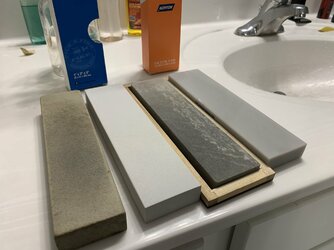What’s going on everyone. I hope this thread starts out with a more productive premise than the last one I posted.
So I keep running in the same situation while attempting a full Arkansas stone progression. I’ll pick up some visible swarf early on with each stone and then all of a sudden it just seems to stop. There seems to be gaps between stones that I don’t know how to bridge.
For example a translucent may help clean up what the hard Arkansas left behind but only up to a point. And honestly I see the same phenomenon between the soft and hard (based on Dan’s rating system).
I am very unclear how to effectively bridge gaps between these stones.
I’ve thought about changing the surface texture on each stone (bringing it from 220 up to 600 or more perhaps) bringing the texture up progressively as needed while honing. I’m not sure that having each side at two different grit levels is incremental enough.
I have a feeling that I’m going to need a lot of W/D….
So I keep running in the same situation while attempting a full Arkansas stone progression. I’ll pick up some visible swarf early on with each stone and then all of a sudden it just seems to stop. There seems to be gaps between stones that I don’t know how to bridge.
For example a translucent may help clean up what the hard Arkansas left behind but only up to a point. And honestly I see the same phenomenon between the soft and hard (based on Dan’s rating system).
I am very unclear how to effectively bridge gaps between these stones.
I’ve thought about changing the surface texture on each stone (bringing it from 220 up to 600 or more perhaps) bringing the texture up progressively as needed while honing. I’m not sure that having each side at two different grit levels is incremental enough.
I have a feeling that I’m going to need a lot of W/D….
Last edited:





